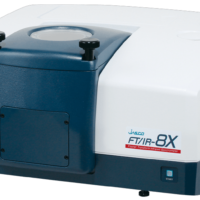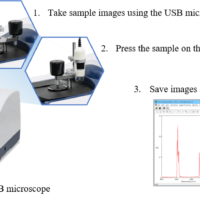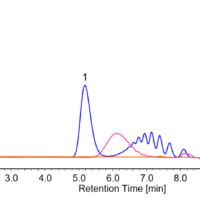Introduction
It has been over two decades since Fourier Transform Infrared (FTIR) Imaging has become commonly used, this is due to advances made in multichannel infrared microscopes. During this period, in order to accommodate increasingly diverse sample types and measurement goals, products have been developed that focus on new and improved accessories and analysis algorithms. JASCO has recently developed several innovative IR imaging systems as shown below including an infrared light path scanning imaging system for an FTIR microscope, with a completely new concept for attenuated total reflectance (ATR) objectives. In this presentation, details of these systems are described and demonstrated using examples from real-world applications.
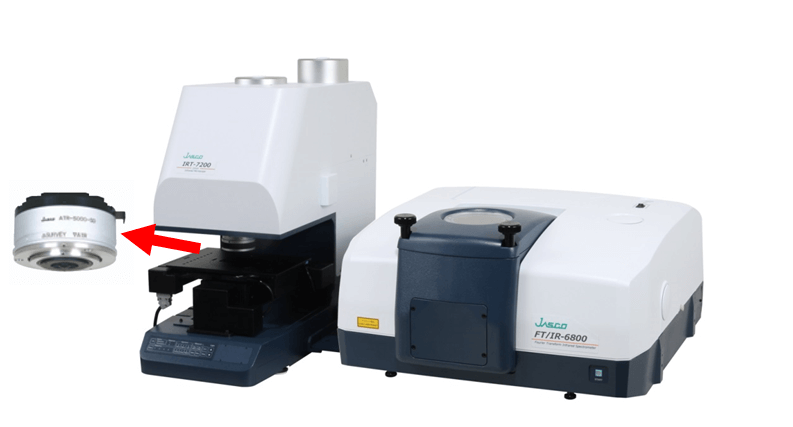
FT/IR-6800FV+IRT-7200 with ATR-5000-SD
Development of an FTIR Microscopy System and ATR Objective
JASCO has developed two distinct types of FTIR microscope; IRT-5200 and IRT-7200. Both have ‘IQ-Mapping’ as a core function, which enables the measurement point to be moved by scanning the infrared beam over the sample and collect imaging data without any requirement to move a motorized sample stage. In micro-ATR measurement, this allows the measurement of a sample that is not located directly at the center of the prism, and makes it possible to perform measurements on viscous samples without cross-contamination and with reduced measurement time.
In addition, we developed a ‘View-Through’ ATR objective (ATR-5000-S Series) for observing the sample when it is in close contact with the prism.
System Configurations
FT/IR-6000FV : Flagship model with Full-Vacuum system
Micro-FTIR
IRT-5200: IQ-Mapping
IRT-7200: IQ-Mapping and Linear-array MCT detector (Max. 9600 spectra per min.)
All models equip ATR pressure sensor as standard in ATR measurement.
ATR Objective (ATR-5000-S Series)
ATR-5000-SS (ZnS prism) : Observation of sample in contact with prism
ATR-5000-SD (Diamond prism): Observation of sample in contact with prism
FTIR Imaging Microscopy without Moving Stage – IQ Mapping
IQ Mapping enables the point of measurement to be varied in the scanning light path. This system was designed to obtain equivalent spectra at all points and to satisfy the total reflection condition at any point in the IQ Mapping area. A confirmation of the effectiveness of this design can be seen here; ATR Imaging of water using IQ Mapping, proves that spectra shape and peak intensity of O-H absorption are uniform across the entire imaging area, and spectra of a high refractive index sample (polycarbonate, n = 1.59) at the center and edge of the light scanning area, show that spectra were obtained equally and without distortion or baseline slope.

‘View-Through’ ATR Objective
The ‘view-through’ ATR objective allows switching between normal observation mode and ATR mode in a single objective lens. The prism is made from ZnS or diamond which is transparent to visible and infrared light, thereby the ‘view-through’ ATR objective enables measurement and observation simultaneously when the sample is in contact with the prism.
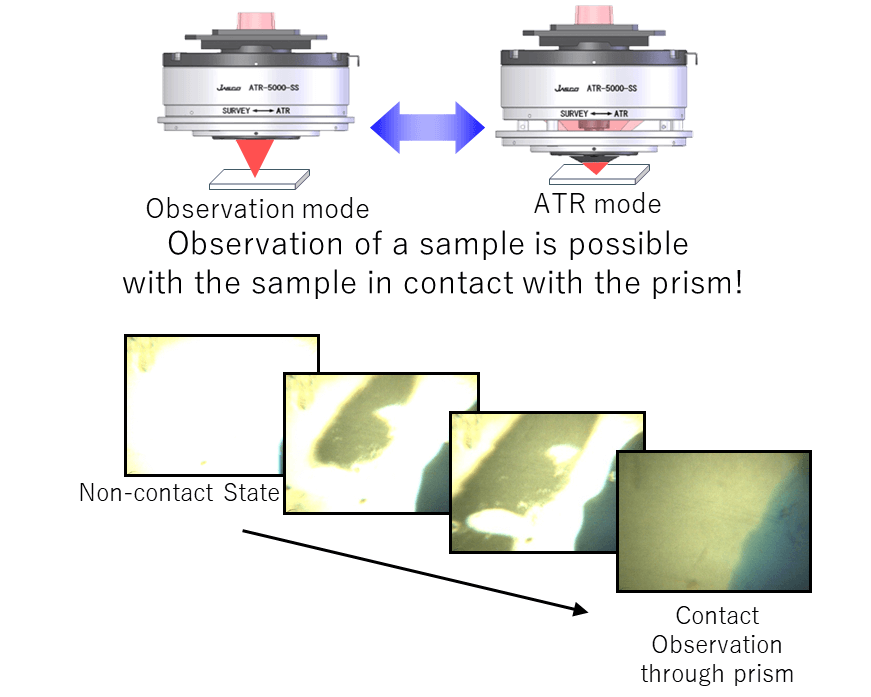
Application of Combination with IQ Mapping and View-Through ATR
By combining the ‘View-Through’ ATR objective and ‘IQ-Mapping’ techniques, we can obtain a visible image of the contact observation together with chemical imaging IR data at a single point of contact and without moving an XY stage. This eliminates cross-contamination. It also saves time during sample measurements and minimizes the risk of the sample moving or being damaged when changing the point of contact for the measurement.
Applications of this system include analysis of the particle distribution in oil samples and IR imaging of the interface between solids and liquids.

Development of ATR Objective for Wide-Area Imaging with High-Throughput
We have also developed another type of ATR objective, ATR-5000-MG. This ATR objective achieves high-throughput using a new design and enables wide-area imaging in a single contact point in combination with ‘IQ-Mapping’.
In addition, because all JASCO Micro FTIR ATR systems include a pressure sensor ensuring correct contact of ATR objective with the samples for adequate contact without damage. Combining the ATR-5000-MG with the pressure sensor allows any FTIR microscope users to measure wide-area ATR imaging more easily and with good reproducibility.

Application of Wide-Area Imaging ATR Objective (Measurement of Gel Sheet with Micro-Capsules)
This example describes the analysis of a micro-capsule in a cooling gel sheet using the ATR-5000-MG wide-area imaging ATR objective. The capsule can be easily burst if too much pressure is applied. So in this case, imaging measurements were performed at controlled pressure using a pressure sensor and spectra were collected at several pressures. At low pressure (0.1 and 0.4 kgf), the distribution map of gel and capsule is described. But when greater pressure was applied (0.7 kgf), the capsule burst and enclosed liquid leaked out. So, three components are seen in the distribution map at 0.7kgf. After measurement at the pressure above, imaging measurement was performed at no pressure and only spectra of the liquid was detected in the entire imaging area. This result shows that the micro-capsule was burst by excessive pressure, and liquid exuded from the gel. This is because the distribution map with no contact with the gel sheet after pressure was removed shows that liquid remained on the prism surface.
ATR imaging with a pressure sensor should be applied to samples that are sensitive to pressure, such as soft materials and bio materials, and also to experiments that observe the changes in a sample when the applied pressure is varied. In addition, it is also valuable for routine measurement because they can be more easily and quickly performed at specified and reproducible pressures, independently of the operator. The ATR-5000-MG which can measure wide area in a single contact can be applied to morphology analysis of blended polymers or rubbers, pharmaceutical tablets, viscous foods and so on. And even if the refractive index of a sample is high, non-distorted spectra can be obtained.
Measurement Conditions
Microscope : IRT-7200
Objective Lens : ATR-5000-MG
Imaging Area : 400 x 400 mm (12.5 x 12.5 mm / pixel)
Points : 32 x 32 (1024 points)
Resolution : 8 cm-1
Accumulation : 50 times
Pressure: 0.1, 0.4, 0.7 kgf
0.0 kgf (after pressurized)
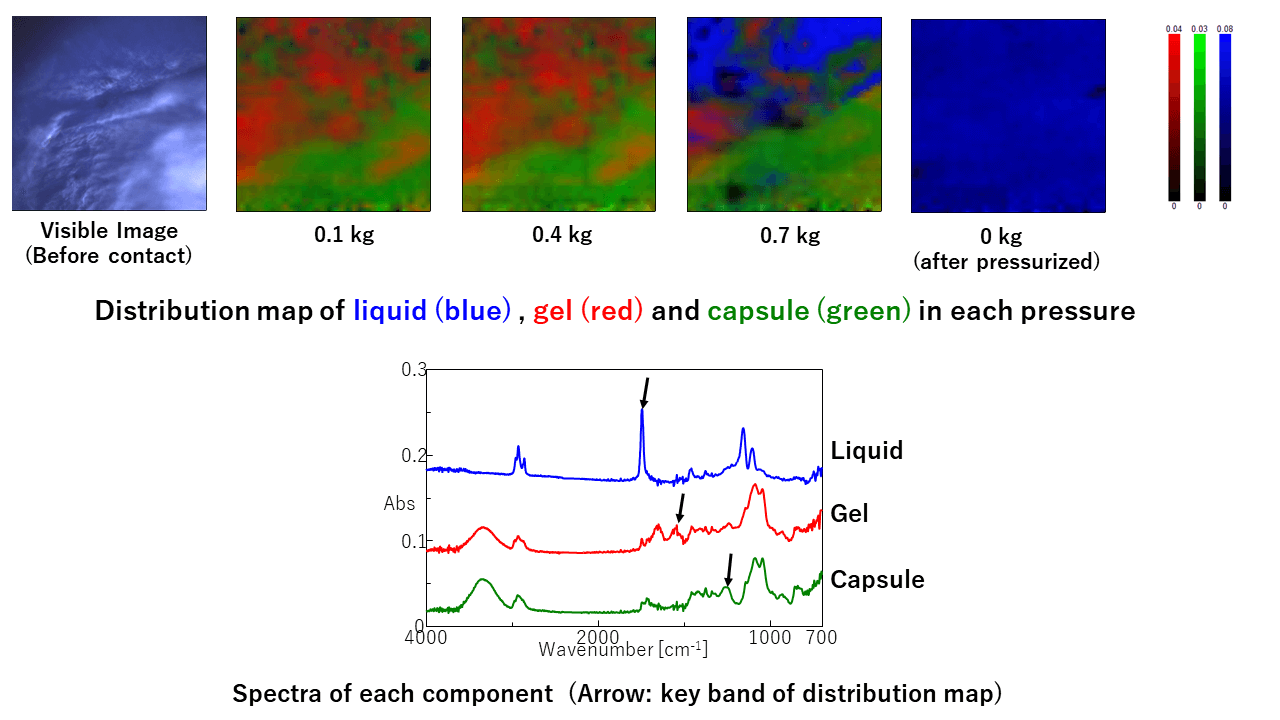
Conclusion
Development of FTIR Microscopy System and ATR Objective
JASCO has developed unique FTIR microscopy systems with ‘IQ-Mapping’ and ‘view-through’ ATR objectives. ‘IQ-Mapping’ enables imaging data to be acquired without moving a sample stage by scanning the IR beam. And the ‘view-through’ ATR objectives, can be used to observe a sample through the ATR prism in contact. A Cassegrain objective is combined with a zinc sulfide or diamond ATR prism, which are transparent to light in both the visible and IR wavelength regions, and can observe and measure visible and IR images simultaneously. By combining ‘IQ-Mapping’ function with a ‘view-through’ ATR objective, a visible image in contact and spectra from not only the center of a prism but the entire field of view can be obtained without any contamination or cumbersome repeated contact to the sample with a prism. Combining these methods will expand the application of FTIR microscopy for foreign materials in fluids, liquids or viscous gels and micro samples which are difficult to handle.
Development of ATR Objective for Wide-Area Imaging with High-Throughput
In addition, JASCO developed a new concept of ATR objective, the ATR-5000-MG, which can measure with excellent throughput an area of 400 x 400 µm in a single contact position. By combining with JASCO’s ‘IQ-Mapping’ function with a pressure sensor, the ATR-5000-MG offers easy, stable, non-destructive and non-contaminated ATR imaging in wide area and it is expected to be applied to viscous samples, biological samples, foods, soft materials and so on.
References
Poster session at ICAVS9 in Victoria, Canada 2017
Kohei Tamura1, Miyuki kanno1, Kenichi Akao1, Jun Koshoubu1, Hiroshi Sugiyama1, Keisuke Watanabe1, Koushi Nagamori1, Frank S. Weston2
1 JASCO Corp., 2967-5 Ishikawa-machi, Hachioji-shi, Tokyo, 192-8537, Japan,
2 JASCO Incorporated, 28600 Mary’s Court, Easton, MD, 21601, USA

